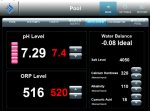So -
I have the Intillichem hooked up. Brand new unit and probes. PH management functionality is perfect. ORP is showing 520ish with perfectly balanced (ideal -.08 LSI).
My numbers
FC =2.8
CC = 0
PH=7.29
CH =320
Alk=110
CYA=18
NaCL=3800
I have read a bunch of posts just saying to use timed dosage as this is typically caused by ORP supression- and I can do that as I know how long to run the IC40 at 100% to get the chlorine generated my pool needs on the 12 hour run schedule. However, that is not why I invested in this and given the plumbing and routing, I do not see how it could be picking up the hydrogen. I invested in this to be fully automated so I would like to get it to work as intended.
Thanks,
Tim




I have the Intillichem hooked up. Brand new unit and probes. PH management functionality is perfect. ORP is showing 520ish with perfectly balanced (ideal -.08 LSI).
My numbers
FC =2.8
CC = 0
PH=7.29
CH =320
Alk=110
CYA=18
NaCL=3800
I have read a bunch of posts just saying to use timed dosage as this is typically caused by ORP supression- and I can do that as I know how long to run the IC40 at 100% to get the chlorine generated my pool needs on the 12 hour run schedule. However, that is not why I invested in this and given the plumbing and routing, I do not see how it could be picking up the hydrogen. I invested in this to be fully automated so I would like to get it to work as intended.
- The flow cell input is very far up stream from the IC40; about 6 feet of bends, elbows, a check valve and the heater are between the flow cell input and the IC40. This is plumbed exactly how the manual indicates (down to the check valve).
- I have 7 pool returns around the perimeter and have had the skimmers off to only pull main drain water in to ensure fully mixed water is entering the system.
- I have shielded the flow cell from direct sun
- I have an auto cover that has the pool covered 23 hours a day
- My VS pump runs at 1610 rpm for 12 hours and flows just slightly over enough to keep the flow lights triggering on the IC40 and IChem
- The probe is a gold type and is clean and brand new
- What else has worked for other Ichem users to get them to function as intended? (maybe a moderator could create a forum just for Ichem owners)
- is there a test solution to verify accuracy to in the 700mv range?
Thanks,
Tim





